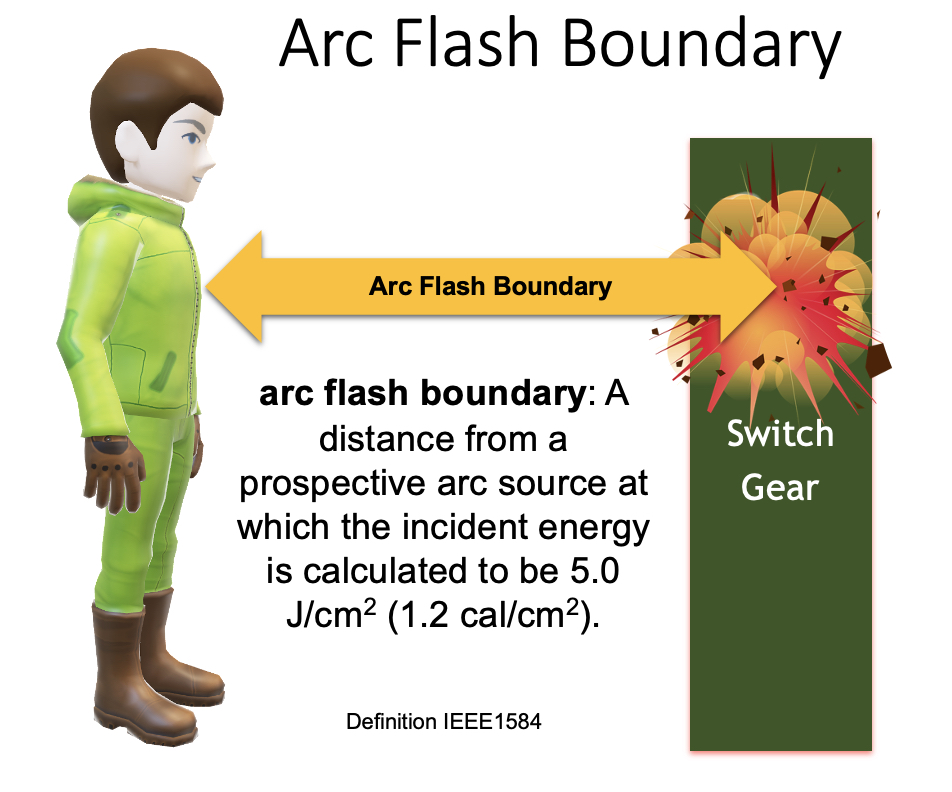4.1.3 Arc Flash Boundary
By performing hazard severity calculations, the onset of where a second-degree burn can occur, (or partial thickness burn) may be predicted at a distance from the possible arcing source. As explained earlier this figure is 1.2 cal/cm2.

Figure 4.1
The distance at which this figure is calculated is called the arc flash boundary and is used within US and Canadian safety standards to determine the measures that will be required to protect workers. (See Chapter 16: Rules, Codes and Legislation) In Europe, this is a very useful piece of information and will allow duty holders to determine risk control measures such as a boundary within which PPE may be required as part of specific safe working procedures. Another example may be designers who need to determine working distances around electrical equipment.
4.1.4 Fault Level Information and the Strength and Capability of Equipment.
When predicting the incident arc flash hazards, knowledge of fault levels will be required. If the information is available, that is fine, but there is an online prospective short circuit current calculator to assist if not. The determination of prospective short circuit current levels is required by designers and duty holders to ensure that equipment is capable of clearing fault currents safely. This may look like a spin off from carrying out the arc flash hazard calculations, but as can be seen from the instructions, a check on the strength and capability is a necessary part of the risk assessment.
4.1.5 Competence
Technical knowledge and experience about the system to be worked on or near is a key ingredient in the assessment of competence of the individual undertaking that work. Among other things, the scope of technical knowledge or experience may include an understanding of the hazards which may arise during the work and the precautions which need to be taken. In addition, the worker must be able to recognise at all times whether it is safe for work to continue. The hazard assessment provides good information about how severe the outcome of an unplanned event will be. Although the aim must always be to avoid the hazard in the first place, there is now the technology available based on sound research to determine the protection measures for workers. There is much more information about competence in Chapter 6: Process, Policies and Procedures.
4.1.6 Personal Protective Equipment Requirements
To be able to comply with the European Council Directive 89/656/EEC (Use of Personal Protective Equipment), the selection of control measures including PPE would be very difficult to achieve without some measure of the actual hazard. (You can find the specific legislation in Chapter 16: Rules, Codes and Legislation for the UK and Ireland). PPE can only be prescribed after the employer has analysed and assessed the risks which cannot be avoided by other means. For arc flash this means that an employer must consider other means of achieving safety prior to considering the use of PPE, such as the elimination of hazard, engineering controls and safe systems of work. For further information, See Chapter 7: Protection.
4.1.7 Ballistic Effects or Arc Blast
As described within the Chapter 2: What is Arc Flash, there could also be an explosive force called arc blast which can be responsible for blunt force injuries. Whilst there are a few myths around the subject of arc blast, there are the means to calculate blast pressure in accordance with theoretical formulae developed by Ralph H Lee, IEEE Life Fellow, in 1987. According to the same formulae, the blast pressure is directly proportional to the arcing current. Therefore, a doubling of the arc current will result in a doubling of blast pressure. There needs to be some caution about the use of the formulae which is conservative at best, but this is discussed in the earlier Chapter 2: What is Arc Flash.
4.2 Hazard Calculation Methods
The accompanying calculators, tools and tables follow various published formulae and white papers but by far the most prominent is the IEEE 1584 Guide for performing Arc Flash Hazard Calculations.
4.2.1 IEEE 1584 Guide for Performing Arc Flash Hazard Calculations.
The IEEE, Institute of Electrical and Electronic Engineers, is the largest professional engineering body in the world and is responsible for the IEEE 1584 Standard. IEEE 1584 is widely seen within the worldwide electrical engineering community as a valid means of determining incident energy levels and arc flash boundaries and calculations are auditable against this standard. The standard does not offer any advice or recommendations in respect of personal protective equipment or any other mitigation measures.